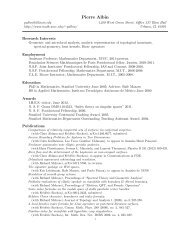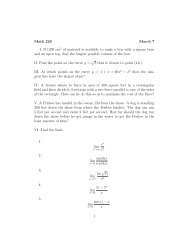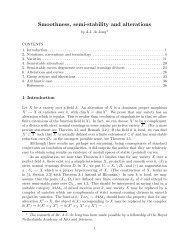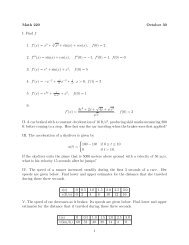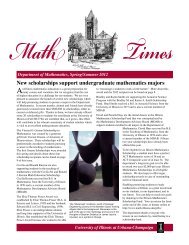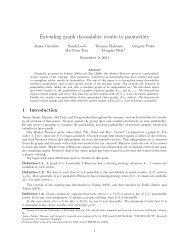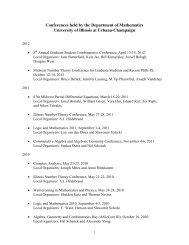Test 1 Practice Questions (First set) (1) Consider the following linear ...
Test 1 Practice Questions (First set) (1) Consider the following linear ...
Test 1 Practice Questions (First set) (1) Consider the following linear ...
You also want an ePaper? Increase the reach of your titles
YUMPU automatically turns print PDFs into web optimized ePapers that Google loves.
<strong>Test</strong> 1 <strong>Practice</strong> <strong>Questions</strong> (<strong>First</strong> <strong>set</strong>)<br />
(1) <strong>Consider</strong> <strong>the</strong> <strong>following</strong> <strong>linear</strong> system and answer <strong>the</strong> questions.<br />
⎧<br />
⎨<br />
⎩<br />
x + y − z = −2<br />
3x − 5y + 13z = 18<br />
x − 2y + 5z = k<br />
(a) Write down <strong>the</strong> augmented matrix.<br />
(b) For which k does this system have one solution?<br />
(c) Is <strong>the</strong> coefficient matrix A invertible? Explain your answer.<br />
(d) Let A be <strong>the</strong> coefficient matrix of this <strong>linear</strong> system and let T be <strong>the</strong> <strong>linear</strong><br />
transformation defined by A. Find <strong>the</strong> kernel and image of T .<br />
(2) <strong>Consider</strong> <strong>the</strong> <strong>following</strong> <strong>linear</strong> system and answer <strong>the</strong> questions.<br />
⎧<br />
⎨<br />
⎩<br />
x + 2y + 3z = 4<br />
x + ky + 4z = 6<br />
x + 2y + (k + 2)z = 6<br />
(a) For which k does this system have a unique solution?<br />
(b) When is <strong>the</strong>re no solution?<br />
(c) When are <strong>the</strong>re infinitely many solutions?<br />
(3) Find <strong>the</strong> polynomial of degree 2 whose graph goes through <strong>the</strong> points (1, 1), (2, 3)<br />
and (3, 13).<br />
(4) Find all vectors in R3 that are perpendicular to <strong>the</strong> <strong>following</strong> two vectors:<br />
⎡<br />
v1 = ⎣ 1<br />
⎤<br />
⎡<br />
3 ⎦ , and v1 = ⎣<br />
0<br />
1<br />
⎤<br />
1 ⎦ .<br />
1<br />
(5) The cross product of two vectors in R3 is given by<br />
⎡ ⎤ ⎡ ⎤ ⎡<br />
⎣ a1<br />
a2<br />
a3<br />
⎦ ×<br />
⎣ b1<br />
b2<br />
b3<br />
⎦ =<br />
⎣ a2b3 − a3b2<br />
a3b1 − a1b3<br />
a1b2 − a2b1<br />
Now fix an arbitrary vector v in R 3 . Is <strong>the</strong> transformation T (x) = v × x from R 3 to<br />
R 3 <strong>linear</strong>? If so, find its matrix in terms of <strong>the</strong> entries of v.<br />
(6) Suppose a line L in R3 contains <strong>the</strong> vector<br />
⎡ ⎤<br />
u =<br />
⎣ a1<br />
a2<br />
Find <strong>the</strong> matrix A of <strong>the</strong> <strong>linear</strong> transformation T (x) = proj L(x).<br />
1<br />
a3<br />
⎦ .<br />
⎤<br />
⎦ .
(7) For<br />
A =<br />
⎡<br />
⎢<br />
⎣<br />
0 1 2<br />
0 2 4<br />
0 3 6<br />
1 4 8<br />
(a) Find a vector b in R 4 such that <strong>the</strong> system Ax = b is inconsistent;<br />
(b) Find a vector c in R 4 such that <strong>the</strong> system Ax = c is consistent.<br />
<br />
1 10<br />
(8) Let A =<br />
. Find a scalar λ such that A − λI2 fails to be invertible. For<br />
−3 12<br />
each scalar λ you find, find a nonzero vector x such that Ax = λx.<br />
(9) Answer <strong>the</strong> <strong>following</strong> questions<br />
(a) Describe <strong>the</strong> kernel of <strong>the</strong> matrix ⎣<br />
⎡<br />
⎤<br />
⎥<br />
⎦ ,<br />
1 1 1<br />
1 2 3<br />
1 3 5<br />
(b) Describe <strong>the</strong> image of <strong>the</strong> <strong>linear</strong> transformation T (x) = Ax for A = ⎣<br />
(10) For <strong>the</strong> matrix<br />
⎡<br />
A = ⎣<br />
0 1 0<br />
0 0 1<br />
0 0 0<br />
describe <strong>the</strong> images and kernels of <strong>the</strong> matrices A, A 2 , A 3 .<br />
⎤<br />
⎦;<br />
⎡<br />
1 1 1<br />
1 1 1<br />
1 1 1<br />
(11) <strong>Consider</strong> a n × p matrix A and a p × m matrix B such that ker(A) = {0} and<br />
ker(B) = {0}. Find ker(AB).<br />
(12) For two invertible n × n matrices A and B, determine which of <strong>the</strong> formulas below<br />
are necessarily true.<br />
(a) (A + B) 2 = A 2 + 2AB + B 2<br />
(b) A 2 is invertible and (A 2 ) −1 = (A −1 ) 2<br />
(c) A + B is invertible, and (A + B) −1 = A −1 + B −1<br />
(d) (A + B)(A − B) = A 2 − B 2<br />
(e) ABB −1 A −1 = In<br />
(f) ABA −1 = B<br />
(g) (ABA −1 ) 3 = AB 3 A −1<br />
(h) (In + A)(In + A −1 ) = 2In + A + A −1<br />
(i) A −1 B is invertible, and (A −1 B) −1 = B −1 A.<br />
2<br />
⎤<br />
⎦ ,<br />
⎤<br />
⎦.



